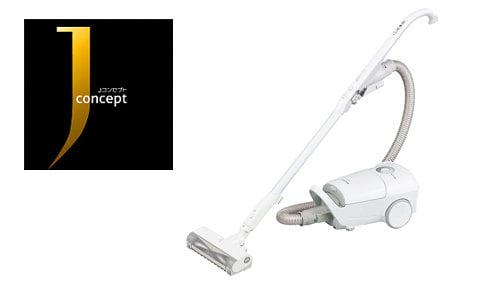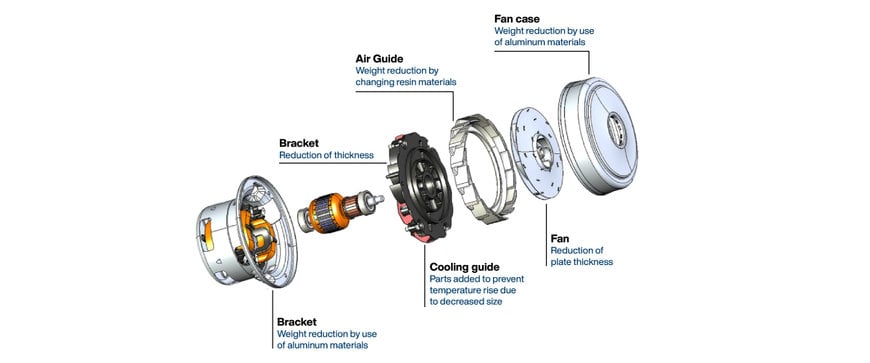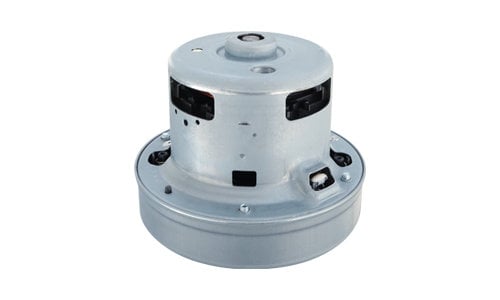www.magazine-industry-usa.com
06
'22
Written on Modified on
Panasonic presents an Ultra light vacuum cleaner motor
The motor is a core component of any household vacuum cleaner unit. The motor directly affects the suction force and total weight of the vacuum cleaner. We developed a motor that weighs approximately 45% less and has an external size of approximately 85% of the conventional vacuum motor.

This new motor design created a significant contribution to reducing the weight and size of vacuum cleaner units.
Challenges
A typical motor is 1/3 of the vacuum cleaner's weight. Therefore, the development of an ultra-light canister vacuum cleaner is centered around fundamental and innovative weight reductions specifically to the vacuum motor.
While cordless vacuum cleaners and robot vacuum cleaners are popular, canister vacuum cleaners are still in demand.
Panasonic Living Appliances and Solutions Company has found great success in their J-Concept series of products. It was their intent to add a canister-type vacuum cleaner to this series to accommodate seasonal market demands. It was their decision to introduce this new vacuum cleaner unit with a significant breakthrough in weight reduction. By combining the wisdom and technology of Panasonic Motor BU's innovative motor redesign, our customer was able to add canister-type vacuum units to their successful J-Concept series of products.
Adopting a new and advanced material (PPFRP) into the vacuum cleaner body resulted in partial weight reduction of the overall unit. The target overall weight reduction could not be realized without innovative redesign of the motor construction. The motor is typically one-third of a vacuum cleaner's total weight.
Efforts
Innovative design changes were made to the basic structure of the motor components.
The realization of designing a lighter weight motor was at direct odds to ensuring its performance. The first step was to identify a level in performance which would satisfy customer requirements.
The raw material of the bracket was changed from iron to aluminum. As a result of the material change, the retention force of the ball bearing was also reduced. As a countermeasure to this side-effect, we changed the holding mechanism for the bearing to a more secure structure.

We also evaluated fundamental changes to the principal motor design, including changes to utilize aluminum magnet wire. All materials used in the construction of the motor were reviewed for improvement opportunity.
Repeated analysis and examination
The central essence of a motor’s performance are the magnetic fields created between the rotor and stator cores. Any slight change or reduction of material to the core designs will directly impact the performance of the motor. We repeated multiple cycles of manipulating the core design, coupled with testing and analysis. This consisted of trimming material and studying the magnetic field to remove redundant portions that have no effect on magnetic force and performance.
The material thickness of the bracket was reduced to decrease overall density while maintaining skeletal strength. To deal with material weakness in areas of high stress, structural ribs were added to specific locations to improve that strength.
Joint development with a valued supplier
Collective development for a new power terminal which reliably connects to aluminum magnet wire.
Developed product
Reduction in motor weight by 55% and reduction in vacuum cleaner body weight by 20%


Voice of the design engineering
Comments of vacuum cleaner design engineer
The central concept for this development was to maintain strong-performance and reliable motor quality while significantly reducing the total weight. In this particular case, the vacuum cleaner had already adopted significant transformations in the unit body to realize both reductions in size and weight.
This was accomplished through the use of an advanced material and a new handle design. Our customer marketed these changes as their J-concept. However, the essential element for realizing the J-concept in the finished product was to employ the creation of a lighter weight motor.
Comments of motor design engineer
Usually, to significantly reduce the weight of an electric motor suggests an unattainable request. In addition, it would appear to be impracticable and contrary to reason. The bulk mass of the motor design is constructed of iron and copper.
In order to change this, it was crucial to reexamine the basic design of the motor and reduce the use of heavy metals as much as possible. We needed to consider every avenue for trimming weight out of the motor. In our initial efforts and design considerations, we struggled to reduce the weight while ensuring quality and without incurring significant cost increases. But with the cooperation of valued suppliers and collaboration of departments within the company, we were able to realize our objectives for a lighter-weight motor design.
In short, we accomplished a new design which we could move forward with and promote with confidence. It is our desire to continually develop new motors that will satisfy our customers and embrace their visionary requirements for new products.
www.industry.panasonic.com

